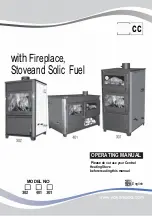
25
Encore
®
FlexBurn
®
2040 Non-Catalytic / Catalytic Wood Burning Stove
30005295
Encore
®
Control Settings
(Refer to the first page of the Operation section.)
DO NOT OPERATE THE STOVE WITH THE ASH DOOR
OPEN. OPERATION WITH THE ASH DOOR OPEN CAN
CAUSE AN OVER-FIRING CONDITION TO OCCUR.
OVER-FIRING THE STOVE IS DANGEROUS AND CAN
RESULT IN PROPERTY DAMAGE, INJURY OR LOSS
OF LIFE.
Conditioning Your Stove
Cast iron is extremely strong, but it can be broken with a
sharp blow from a hammer or from the thermal shock of
rapid and extreme temperature change.
The cast plates expand and contract with changes in
temperature. When you first begin using your Encore
®
,
minimize thermal stress by letting the plates adjust gradu-
ally during three or four initial break-in fires following Steps
1-3 below.
Non-Catalytic Wood Burning
Burn only solid wood in the Encore
®
, and burn it directly
on the grate. Do not elevate the fuel. Do not burn coal or
other fuels.
The bypass damper must be open when starting a fire
or when refueling.
Do not use chemicals or fluids to start the fire. Do
not burn garbage. Never use flammable fluids such as
gasoline, gasoline type lantern fuel, kerosene, charcoal
lighter fluid, naptha, engine oil or similar liquids to
start or “freshen up” a fire in this heater. Keep all such
liquids well away from the heater while it is in use.
1. Open the stove bypass damper, and open the primary
air control fully.
2. Place several sheets of crumpled newspaper in the
stove. Place six or eight pieces of dry kindling split to a
finger-width size on the paper. On the kindling, lay two
or three larger sticks of split dry wood approximately 1-2"
(25-51 mm) in diameter. (Fig. 37)
ST263
starting a fire
12/99
ST263
Fig. 37
Start the fire with newspaper and dry kindling.
3. Light the newspaper and close the door. Gradually build
up the fire by adding a few 3-5" (80-120 mm) diameter
pieces of split firewood.
If this is one of the first few
“break-in” fires, let the fire burn brightly, and then let
it die out.
During the break-in fires, do not let the stove get hotter
than 500°F. (260°C) as measured on an optional stove-top
thermometer. Adjust the air control lever as necessary to
control the fire.
Some odor from the stove’s hot metal and the paint is
normal for the first few fires.
NOTE:
Some chimneys must be “primed,” or warmed up,
before they will draw sufficiently to start a fire. To correct
this situation, roll up a couple pieces of newspaper, place
them on top of the kindling and toward the back of the
stove, light them, and close the doors. This will encourage
the smoke to rise rapidly, making it easier to establish a
good draft.
Once the draft is established, open the front door and light
the rest of the fuel from the bottom. Do not light the main
bed of fuel until the chimney begins drawing, and repeat
the procedure as often as necessary if the initial attempt
is unsuccessful.
NOTE:
Effectiveness of a "top-down" method to start a
fire. Smoke emissions when starting a fire can be difficult
to control because the stove is not yet heated to its optimum
temperature. One method of reducing emissions during a
cold start-up is the use of a "top-down" kindling procedure.
In this, place larger pieces of kindling on the bottom of the
kindling pile followed by smaller and smaller pieces as the
pile is added to. Very finely split pieces should be on the
top. Light the kindling pile with a match at the top and allow
the kindling to burn downward into the larger pieces. This
reduces smoke by slowly increasing the fire size without
creating an air-starved condition.
4.
If your Encore
®
has been broken-in previously
using
Steps 1-3, continue to build the fire gradually. Add larger
wood with a diameter of 3-4" (75-100 mm). Continue adding
split logs of this size to the briskly-burning fire until there
Burn Rate
Primary Air Control
Low
From far right to 1/3
the distance to left
Medium
From 1/3 to 2/3
the distance to left
High
From 2/3 the distance
to left, to far left
















































